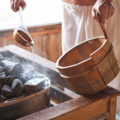Taking a sauna is healthy

The cold season is just around the corner and with it the high season for colds, sniffles, influenza and corona viruses. For two years, strict hygiene regulations were just as much part of everyday life as wearing masks, disinfection and keeping your distance.
After two years of pandemic, you can now take a proper sauna again. However, sauna operators have already announced price increases due to high energy costs. Even the Finns are said to take a sauna only once a week because of the energy crisis. Many people ask themselves whether saunas will soon become a luxury.
For the ninth time, Sauna Day was celebrated all over Germany. The motto this year is: “SAUNA. A healthy pleasure.” This is intended to focus on the positive health aspects of sauna bathing for the body and psyche. Sauna Day – every year on 24 September – is a joint campaign of the German Sauna Association and many sauna businesses.
With Sauna Day, the German Sauna Association launched a nationwide campaign day for public saunas in 2014, which is becoming increasingly popular with sauna operators and sauna guests as well as the media. “We’re in!” is therefore the motto for the start of the peak sauna season in autumn.
Motto of the year: “Medical Wellness”. With this year’s representative survey among sauna-goers, the association wanted to find out which aspects of sauna bathing are the most enjoyable.
The result shows that switching off and recovering from everyday life (52%) takes first place among German sauna guests. The alternation of hot and cold stimuli (18 %) takes second place among respondents. The third place in terms of mentions is shared by the feeling of bathing in the sauna unclothed and participation in experience-oriented show/event infusions.
Probably the best-known effect of sauna bathing is conditioning. The interplay of warmth and cold stimuli improves the blood circulation regulation of the skin and mucous membranes and strengthens the cardiovascular system.
Another positive effect: Although cellulite cannot be sweated away, the connective tissue can be strengthened by the intensive blood circulation and the skin can be tightened by the subsequent cooling. Toxins that can cause water retention are also flushed out through sweat.
Taking a sauna helps the psyche
Sauna helps against stress – both body and soul benefit from the relaxation the sauna offers. Studies provide evidence that taking a sauna properly leads to an increased release of the happiness hormones endorphin and serotonin. Thus, according to the studies, regular saunas help to improve the basic mood and can even contribute to the treatment of depression.
Take a sauna properly
To achieve a positive effect, up to three sauna sessions are recommended per week. For healthy people, there is nothing to stop them from even taking a sauna every day. However, it should be noted that if you visit the sauna several times a week, you should reduce the number of sauna sessions per day. After the last sauna session, you should drink enough, preferably water, to compensate for the loss of fluids.
By the way: Do not take a sauna on an empty stomach. It is better to eat something before going to the sauna so that the body is strengthened. After the sauna sessions, it is recommended to eat only light food such as salads, soups or fruits.
Under no circumstances should you go to the sauna if you have a fever, infections, acute attacks of rheumatism, inflammatory skin diseases, open wounds or cardiac arrhythmias that cannot be controlled. However, after a heart attack, in consultation with the cardiologist, sauna sessions can be used to prevent another heart attack.
Incidentally, it is a myth that you can lose weight by going to the sauna. A sauna session consumes about 20 kcal (by comparison: a bar of chocolate has at least 500 kcal). You can only lose weight with sport, exercise and a healthy diet.
Taking a sauna before exercise is not recommended. Experts agree that going to the sauna before training is counterproductive. This is because the enormous loss of fluid through sweating in the sauna has a negative effect on the functionality of the muscles and you are less efficient as a result.
Many sauna-goers make the mistake again and again of taking a cold shower immediately after leaving the hot cabin. It is more gentle on the circulation to first take a cool air bath for a few minutes.
Our advice is: Drink plenty of fluids before your first sauna session, do not eat heavy meals and – do not forget – be sure to take a shower. You should also be in good physical condition. In case of any questions, medical clarification is required in advance.
The most important types of sauna include the Finnish sauna, the Earth sauna, the Smoke sauna, the Infrared sauna, the Hammam, the Tepidarium, the Caldarium, the Irish heat bath, the Banya and the Bio sauna.
The Finnish sauna is probably the one we know best. The Finnish sauna is considered the most traditional form of sauna and is the first thing that comes to mind for many people when it comes to the topic of saunas. At the same time, with temperatures of around 90 to 100 degrees Celsius, this is the hottest of all sauna types.
The length of stay should be eight to a maximum of 15 minutes per sauna session. As water transports heat much better than air, people, at least most, can tolerate 90 degrees in the sauna just fine, while 90 degrees hot water would be extremely painful.
Sauna for heat sensitive people
A bio sauna is a gentle variant of the Finnish sauna. Here, a comparatively lower room temperature of about 55 degrees Celsius is generated with a combination sauna heater. On the other hand, the humidity is higher than in other types of sauna, at around 40 to 55 percent. It is important for sauna novices to have a mild temperature control, as in the hay sauna. There you should sit close to the entrance and on the lower steps in order to get back to the fresh air quickly if necessary.
By the way: Towels and the like are considered unhygienic in most saunas. Towels are therefore not permitted – except as something to sit on. The pores must be able to open during a sauna session. If the body is covered with a towel, this cannot be achieved.
Roman, Irish and Turkish steam baths
Finally, we recommend a visit to the steam bath to cleanse and moisten the mucous membranes and respiratory tract. The difference between a steam bath and a sauna is easily explained: The sauna is hotter, while the steam bath is more humid. During a steam bath, cramped muscles relax and the nerves are calmed. For rheumatic complaints and colds, the visit is particularly beneficial and relaxing. That is why a steam bath is also ideal for colds. A bath should last 10 to 15, maximum 20 minutes.
The Roman steam bath is considered the most popular steam bath of its kind because it only heats up to around 45 to 48 degrees. The steam bath has mild temperatures with extremely high humidity, which encourages you to sweat.
Sauna-goers also sweat in the Irish steam bath at relatively low temperatures of around 50 degrees. An Irish steam bath is a heat bath consisting of several warm and humid rooms. This form of heat bath has existed for around 150 years and was originally practiced in Ireland. A session in the Irish Steam Bath lasts several hours, so you should have plenty of time available.
The Hammam, also known as the Turkish sauna, is the bathing culture par excellence in the Arab world. The Hammam is considered one of the best-known types of sauna in the world. Originally from Turkey, the trend of this oriental steam bath has spread quickly and successfully. The Hammam is valued for its relaxing and vasodilating effects. It therefore relaxes the muscles and relieves pain and discomfort.
But there are risk groups who should not take steam baths. People with severe cardiovascular problems: As a steam bath beginner, with high blood pressure or a weak heart, the steam bath can be too much for your circulation. A stay in the Hammam serves to cleanse the body and relax at a pleasant 50 to 55 degrees and almost 100% humidity.
The Finns are the sauna world champions
Over three million saunas in a country of just 5.5 million people – the sauna has been firmly anchored in Finland’s cultural heritage for centuries. The diversity of the countless sauna variants seems unquestionable; smoke, ice or steam saunas are just a few of them.
The oldest public sauna in Finland is the Rajaportti Sauna
The sauna capital of the world, Tampere, is home to Finland’s oldest surviving public sauna – the Rajaportti Sauna. This is just one of over 50 saunas characteristic of the region. Opened in 1906, it is still largely unchanged today. Wrapped in a gentle steam, guests sweat here on wooden benches that are over 100 years old – and then jump into the nearby lake all year round.
We hope you have fun in the sauna!
Sources:
tagdersauna.de
kurz mal weg.de




